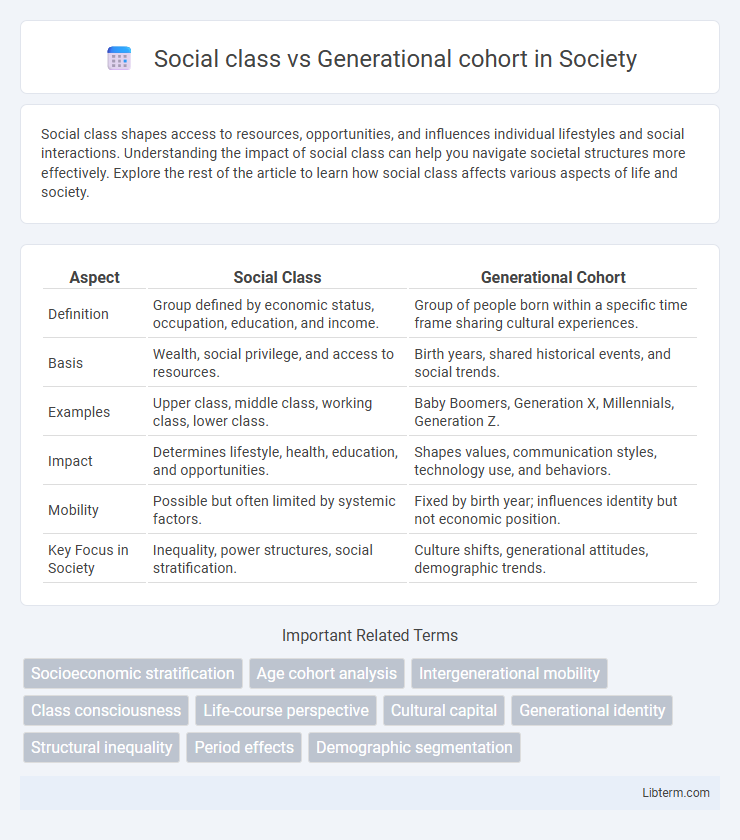Social class shapes access to resources, opportunities, and influences individual lifestyles and social interactions. Understanding the impact of social class can help you navigate societal structures more effectively. Explore the rest of the article to learn how social class affects various aspects of life and society.
Table of Comparison
| Aspect | Social Class | Generational Cohort |
|---|---|---|
| Definition | Group defined by economic status, occupation, education, and income. | Group of people born within a specific time frame sharing cultural experiences. |
| Basis | Wealth, social privilege, and access to resources. | Birth years, shared historical events, and social trends. |
| Examples | Upper class, middle class, working class, lower class. | Baby Boomers, Generation X, Millennials, Generation Z. |
| Impact | Determines lifestyle, health, education, and opportunities. | Shapes values, communication styles, technology use, and behaviors. |
| Mobility | Possible but often limited by systemic factors. | Fixed by birth year; influences identity but not economic position. |
| Key Focus in Society | Inequality, power structures, social stratification. | Culture shifts, generational attitudes, demographic trends. |
Understanding Social Class: Definition and Key Attributes
Social class refers to a group of individuals sharing similar economic status, education levels, and occupational prestige, which collectively influence their lifestyle and opportunities. Key attributes include income, wealth, education, and cultural capital, shaping access to resources and social mobility. Understanding social class is essential for analyzing generational cohorts, as class background significantly affects attitudes, behaviors, and life outcomes across different age groups.
Generational Cohorts: Identifying Distinct Age Groups
Generational cohorts are distinct age groups defined by shared experiences, cultural events, and historical contexts that shape their values and behaviors. Unlike social class, which is based on socio-economic status and resources, generational cohorts such as Baby Boomers, Generation X, Millennials, and Generation Z reflect differences in technology adoption, communication styles, and social attitudes. Marketers and sociologists identify these cohorts to target customized strategies and understand evolving consumer patterns across age groups.
Historical Context: Social Class and Generational Shifts
Social class structures have continuously evolved through industrialization, war, and economic transformations, influencing generational cohorts differently across historical contexts. Each generation's experience, from the working-class struggles during the Great Depression to the middle-class expansion post-World War II, shaped distinct values and social mobility opportunities. These shifts highlight how social class and generational identity intersect, reflecting broader socio-economic changes over time.
The Interplay Between Social Class and Generation
Social class significantly influences the values, behaviors, and opportunities experienced by different generational cohorts, shaping their unique cultural and economic perspectives. Generational cohorts navigate and interpret social class structures differently due to historical contexts, technological advancements, and evolving societal norms. The interplay between social class and generation creates distinct identity formations and socio-economic trajectories, highlighting the complex dynamics of privilege, mobility, and cultural capital across time.
Economic Mobility Across Classes and Generations
Economic mobility varies significantly between social classes and generational cohorts, with upper classes generally experiencing greater financial stability and growth over time. Research shows that lower social classes face more barriers to upward mobility due to limited access to education, wealth, and social capital, which often persist across generations. Generational shifts in economic opportunities, such as changes in labor markets and education systems, influence the potential for mobility but do not fully overcome entrenched class disparities.
Cultural Values: How Class and Generation Shape Perspectives
Social class and generational cohorts profoundly influence cultural values, shaping perspectives on work ethic, education, and family roles. Individuals from higher social classes often emphasize individualism and achievement, while lower classes may prioritize community and resilience, with generational differences affecting attitudes towards technology, social justice, and authority. These intersecting factors create diverse viewpoints that inform social behavior, consumer preferences, and political attitudes across society.
Consumption Patterns: Class vs. Generational Influences
Consumption patterns are significantly shaped by social class and generational cohorts, with social class influencing access to resources and preferences, while generational cohorts reflect shared experiences and values that drive demand for specific products. Higher social classes tend to prioritize luxury, quality, and brand prestige, whereas lower classes focus on affordability and practicality. Millennials and Gen Z, for example, emphasize digital connectivity and sustainability, whereas Baby Boomers prefer traditional brands and in-store shopping experiences, highlighting how class-based economic capacity intersects with generational values to shape consumer behavior.
Education and Opportunity: The Role of Social Structures
Social class significantly shapes educational opportunities by influencing access to quality schools, resources, and extracurricular activities, while generational cohorts experience these disparities differently due to shifting social policies and economic conditions. Educational attainment often varies within cohorts based on socioeconomic status, reinforcing or challenging existing social hierarchies. Social structures play a critical role in either perpetuating or mitigating educational inequalities, affecting long-term opportunities for upward mobility across generations.
Social Identity: Navigating Class and Cohort Membership
Social identity shapes how individuals navigate the complexities of social class and generational cohort membership, influencing behaviors, values, and group affiliations. The intersection of class-based resources and cohort-specific experiences creates unique identity formations that affect social mobility and intergenerational communication. Understanding these dynamics enhances insights into social stratification and collective identity within diverse populations.
Future Trends: Evolving Dynamics in Class and Generational Divides
Future trends indicate a growing interplay between social class and generational cohorts, with economic inequality shaping access to education, technology, and career opportunities differently across age groups. Emerging research highlights that younger generations face distinct challenges such as gig economy volatility and student debt burdens, exacerbating class-based disparities. Technological advancements and shifting labor markets are expected to redefine social mobility pathways, intensifying the need for policies addressing both generational and class inequalities.
Social class Infographic

 libterm.com
libterm.com